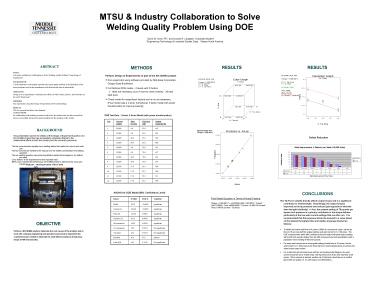MTSU - PowerPoint PPT Presentation
1 / 1
Title: MTSU
1
MTSU Industry Collaboration to Solve Welding
Quality Problem Using DOE
?
David W. Gore, PE1 and Donald R. Langston,
Graduate Student21Engineering Technology
Industrial Studies Dept., 2Nissan North America
- ABSTRACT
- TITLEUniversity and Industry Collaboration to
Solve Welding Quality Problem Using Design of
Experiments - BACKGROUND
- A local automotive seat supplier experienced a
major quality problem in the fabrication of the
metal seat frame used in the manufacture of the
front bucket seats of automobiles. - OBJECTIVE
- Design a set of experiments to determine the
effects of weld current, tip force, and weld time
on the weld break-away" - METHODS
- Run experiments using the Design of Experiments
(DOE) methodology. - RESULTS
- DOE was successful and defects were eliminated.
- CONCLUSIONS
- By collaborating with industry personnel at all
levels, the student team was able to model the
process successfully and provide setup boundaries
for the operation of the welder. - BACKGROUND
- This presentation covers the details of the
Design of Experiments portion of a SIX SIGMA
project that was successfully completed thanks to
the collaborative efforts of both the industry
and the university personnel.
RESULTS
RESULTS
- METHODS
- Perform Design of Experiments as part of the SIX
SIGMA project. - Run experiment using software provided by
Stat-Ease Corporation. - Design-Ease software
- Full factorial DOE model 2 levels with 5
factors. - tests are necessary, plus 4 more to check
linearity 36 total seat pans. - Check model for insignificant factors and re-run
as necessary. - Final model was a 2-level, full factorial, 3
factor model with power transformation to improve
linearity.
DOE Test Data 2-level, 3 factor Model (with
power transformation)
Test Current (Amps) Time (Cycles) Tip Force (psi) Output torque (in-lb)
1 10,000 4.0 35.0 425
2 15,000 4.0 35.0 625
3 10,000 30.0 35.0 500
4 15,000 30.0 35.0 800
5 10,000 4.0 70.0 315
6 15,000 4.0 70.0 407
7 10,000 30.0 70.0 426
8 15,000 30.0 70.0 675
9 12,500 17.0 52.5 480
10 12,500 17.0 52.5 500
11 12,500 17.0 52.5 511
12 12,500 17.0 52.5 500
Defect Reduction
The tier one automotive supplier has a welding
station that welds four nuts to each seat
pan. The four nuts that are welded to the seat
pan are not welded consistently in the welding
operation. The nut welding operation was
producing defective welds that averaged six (6)
defects per week. Zero defects is the
requirement for this important weld. MTSU was
contacted for performing a SIX SIGMA project to
determine the cause and solution.
Seat pan showing location of the 4 weld nuts
- CONCLUSIONS
- The Tip Force variable directly affects output
torque and is a significant contributor to weld
strength. Surprisingly, the output torques
improved as the tip pressure was reduced (just
opposite to what the team thought intuitively).
In fact, the present setting of 70 pounds per
square inch pressure is a primary contributor to
low torque failures particularly at the low weld
current settings that are often run. It is
recommended that this pressure should be lowered
to a value based on the desired throughput time
and welder amperage desired as follows - To obtain the lowest weld time of 4 cycles
(1/60th of a second per cycle), set the tip force
to 35 psi (one-half the original setting) and
weld current to 12,100 amps. The DOE model
predicts within 99 confidence that the lowest
individual torque reading will be 400 inch-pounds
(higher than the 365 inch-pound low limit
specification) with a population mean reading of
500 inch-pounds. - For lower weld current and a more typical setting
of weld time of 10 cycles, set the weld current
to 11,350 amps at the 35 psi tip force
recommended above to achieve the same torque
output values. - For a weld that will not break loose until the
surrounding metal fatigues, the weld current
should be set at 15,000 amps, with tip pressure
at 35 psi and weld time at 30 cycles. If this
outcome is desired, another set of trial parts
should be run to confirm good weld nut quality
(i.e. no weld slag or nut deformation).
ANOVA for DOE Model (99 Confidence Level)
Final Model Equation in Terms of Actual
Factors(Torque 1000.00)2 6.40252E005
158.78376 Current
-24612.00000 Time 9099.00000 Tip force
3.468179 (Current Time) 1.64979( Current Tip
force)
Source F Value ProbgtF Comment
Model 94.35 lt0.0001 significant
Current (A) 224.92 lt0.0001 significant
Time (B) 124.22 0.0001 significant
Tip force (C) 85.11 0.0003 significant
AB interaction 26.59 0.0036 significant
AC interaction 10.9 0.0214 Not significant
Curvature 6.33 0.0534 Not significant
Residual N/A N/A random
Lack of fit 4.91 0.1133 Not significant
OBJECTIVE Perform a SIX SIGMA study to determine
the root causes of the problem and to work with
company engineering and operations personnel to
implement the countermeasures needed to eliminate
the weld defects (minimum break-away torque of
400 inch-pounds).































